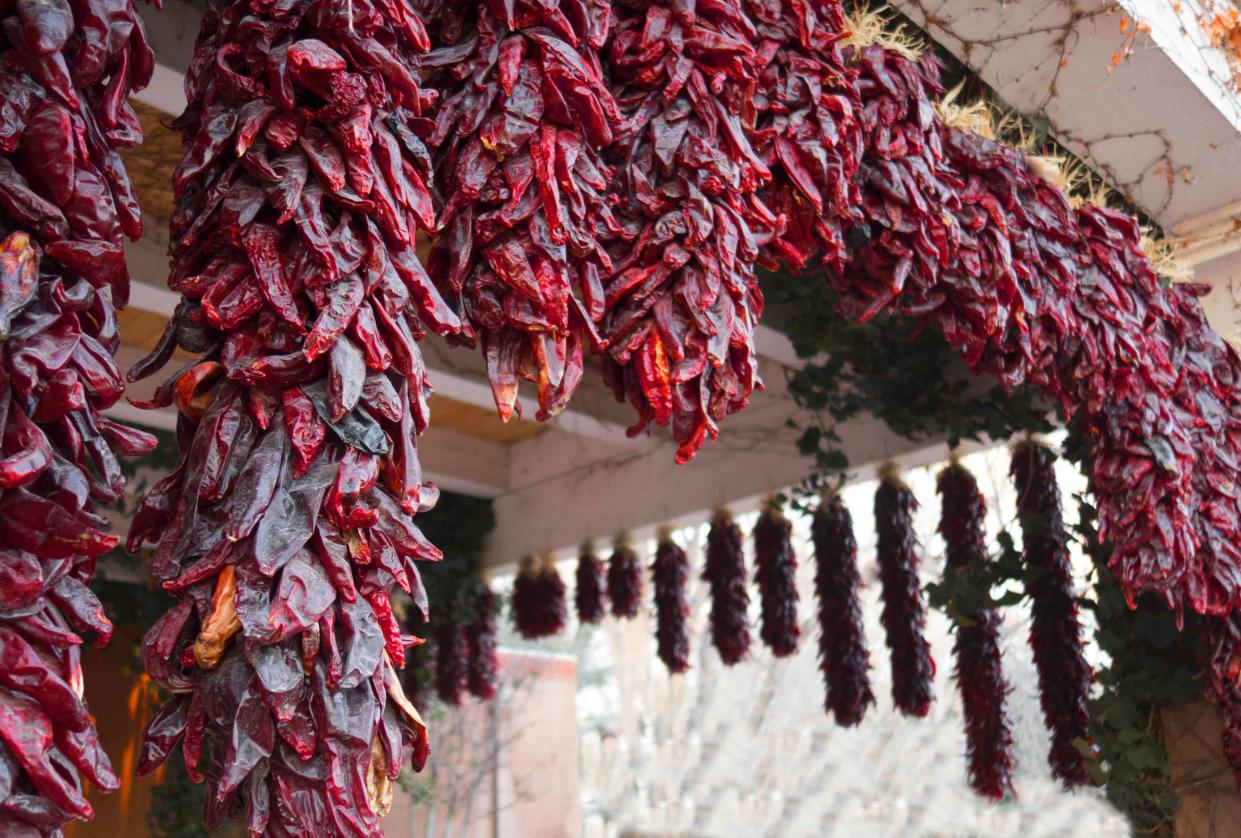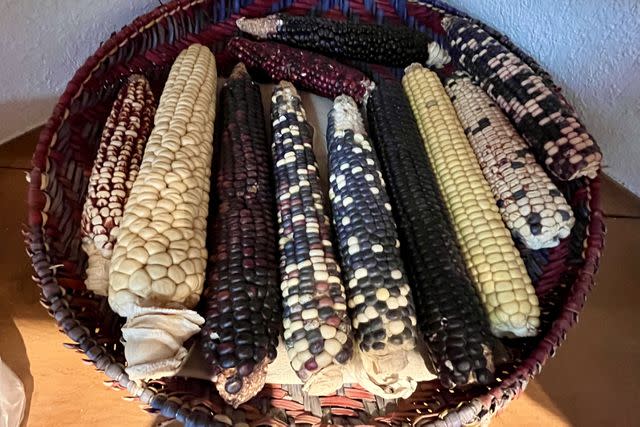A New Native American Cuisine Is Emerging in New Mexico
Blue corn gnocchi and frybread tacos are the modern iterations of Indigenous cuisine, complete with the three sisters and New Mexico's trademark chile peppers.

CampPhoto / Getty Images
“Corn is very sacred to the Zunis,” says Celia Tsabetsaye, an 81-year-old Zuni Pueblo great grandmother in her kitchen on the reservation. “If you drop a kernel, you better ask for forgiveness. It’s like dropping your child.”
Tsabetsaye is showing me how to make traditional cornballs using her mother-in-law’s special blue cornmeal. As her experienced hands carefully roll the balls, she says, “I learned to cook in my grandma’s kitchen. But cornballs are only made for ceremonial purposes nowadays because the diet has become Americanized.”
“It’s important to keep the traditions alive because this is natural food with no additives.” she adds. “I grew up eating it and it’s given me longevity. It’s also important for our culture.”
Tsabetsaye, who has offered visitors cooking demonstrations in the Zuni Pueblo, is part of a growing movement by Native and non-Native cooks alike to preserve the Indigenous foods and foodways of New Mexico.

Veronica Stoddart
Those ancestral foods are founded on the three sisters — corn, beans, and squash — the hallmark staples for centuries of New Mexico’s Indigenous people, including the Navajo, Apache, and Pueblo Indians. When eaten together, they provide a balanced, nutritious meal thanks to the discovery of corn nixtamalization by Indigenous people about 3,000 years ago, whereby corn is cooked in an alkaline solution typically of ash or lime to become more digestible and nutritional. Corn won’t bind together to form dough, or masa, without that process, which allowed Native cultures to thrive. No wonder corn became the most important ingredient in Native American cuisine.
Spicing up the three sisters are equally essential red and green chile peppers. The Pueblo people developed a technique for roasting chiles, which is a signature of many dishes today in this chile-loving state. In fact, “red or green?” is the official state question — a choice between the earthy fruitiness of red chile sauce or the pungent smokiness of the green one.
Related: Why This New Mexico Chile Has an International Cult Following
As these ingredients are being prepared for the modern palate, a new Native American cuisine is emerging. “For the first time in history, Native American chefs and cooks are defining what foods should be included in New Native American Cuisine,” writes food historian, chef, and James Beard Award-winning cookbook author Lois Ellen Frank in Seed to Plate, Soil to Sky. “Today there is a Native foods movement focusing on food sovereignty, the revitalization of Native American foods, and the re-indigenizing of Ancestral Native American foods.”
Some Native chefs are using only pre-Conquest ingredients, such as Jemez Pueblo citizen Tina Archuleta, who owns the country’s only vegan Native American restaurant, two-year-old Itality Plant Based Foods in Albuquerque. “It’s about representing the Pueblo food that’s plant based. We were a plant-based people,” Archuleta tells me over a breakfast of blue corn amaranth waffles and avocado toast made with Pueblo oven bread and garnished with sunflower sprouts and seeds. “A lot of my recipes are centered around the three sisters.” Her signature Hey-Miss Enchilada features squash, kale, and pumpkin “cheese” sauce enveloped in a red chile-infused whole wheat tortilla. “It’s from my Pueblo specifically. Some say eating my food is a spiritual experience because there’s a deep connection to our traditions. People want to experience cultural food.”
Other Indigenous chefs, such as Raymond Naranjo, are using ancestral Native American ingredients along with foods introduced in other historical periods. His food truck, Manko, calls it “Native American Fusion” and offers dishes labeled “Straight from the Rez,” such as Frybread Green Chile Cheeseburger and Red Chile Cheese Fries. “I saw a disconnect with our community and saw only fast-food choices in the Pueblo,” he says. “I’m trying to serve as a bridge and show that frybread (fried wheat bread traditionally made with lard) doesn’t have to be made with animal fat. I use vegetable oil.”
In Central Park Square in Los Alamos, one of the truck’s regular spots, I sample his Native Berries & Bird Seed Salad, whose ingredients “connect us to our past,” he explains. “The spinach is a fasting food for the Pueblo community. The popped amaranth and quinoa are ingredients that arrived from Mexico via ancient trade routes. The roasted sunflower seeds represent the ‘fourth sister’ for the Pueblo people. And the berry vinaigrette and feta cheese are the fusion piece.”
Another fusion enthusiast is chef Ryan Rainbird Taylor, from the Ohkay Owingeh Pueblo, who plans to use ancient cooking techniques he learned from his grandmother (“her red chile stew was famous”) with modern updates as he scouts locations for a restaurant called Popé. Named for the tribal leader, Popay, who famously led the Pueblo Revolt of 1680, the restaurant would feature native ingredients such as cactus, bison, duck, and eel — “which the Pueblo Indians ate a lot,” he says — and dishes such as tacos with blue corn tortillas, duck confit, and the three sisters. “We could do spam and frybread (based on ingredients introduced by government rations), but that wouldn’t represent our traditional food. We’re trying to reclaim our culture so it isn’t appropriated and be a bridge that connects the reservation to the outside world.”
A desire to spotlight their Native heritage also motivates Shyla Sheppard, a member of the Three Affiliated Tribes, and her partner and wife, Missy Begay, from the Navajo Nation. They created the Albuquerque-based Bow and Arrow Brewing Co., which represents an often-overlooked group, especially within the brewing community: Native Americans. Billed as America's only female-owned Native American brewery, “it’s inspired by the Southwest, such as our blue corn Pilsner,” says Sheppard. “We forage for and use wild ingredients like prickly pear, juniper, and neomexicanus, the only hop indigenous to North America. We live and brew on Tewa land and our Native Land beer acknowledges that.”
Celebrating the foods of New Mexico’s 19 Pueblos, each one a sovereign nation, is central to the Indian Pueblo Kitchen in Albuquerque. I head to this Native-themed restaurant, part of the Indian Pueblo Cultural Center, to sample a beloved Native American dish: the Indian taco. To the sounds of American Indian music, I tuck into an open-faced taco on frybread with red and green chiles, diced chicken, Pueblo beans, cheese, lettuce, and tomatoes that spill liberally over the entire plate. It’s a trademark combo of government-issued rations such as wheat flour and lard for the deep-fried frybread and cheese with such traditional indigenous ingredients as beans, chiles, and tomatoes.
I also try two local favorites: blue corn-crusted onion rings with green chile ranch and blue corn-fried pickles marinated in — wait for it — black cherry Kool-Aid (an acquired taste). “Pueblo communities like to use Kool-Aid,” says chef Josh Aragon, who hails from the Laguna Pueblo, as I recall having seen large vats of pickles soaking in Kool-Aid in the Zuni Pueblo general store. He has added bison cabbage stew and free-range elk chili served with housemade blue corn muffins to the menu.
Even non-Native chefs are embracing Native American ingredients, while adding their own spins. Take New Mexican Christopher Bethoney, chef at Albuquerque’s chic Campo restaurant in Los Poblanos Historic Inn. “Corn is the native ingredient most integrated into the menu,” he tells me. “It’s the most important because corn is one of the few ingredients that built civilization. We’re revisiting that now.” Dried heirloom corn (he nixtamalizes corn in house) shows up in ceviche with housemade corn tostadas, lamb birria with blue corn hominy, and wood-fired mushroom huarache on a base of blue corn masa — an earthy, tangy, crunchy flavor explosion.
At Albuquerque’s Level 5 Rooftop Restaurant in the Hotel Chaco, chef Sean Sinclair, a 13th-generation New Mexican, prepares culturally relevant meals using indigenous items like trout, pheasant, quail, and bison instead of beef. “To celebrate the people who were here before the Conquest, we’ll try to feature indigenous things to get as authentic an experience as possible.” His new menu features pheasant sausage-stuffed squash blossoms fried in cornmeal and tamales filled with sweet roasted corn and green chile atop black bean purée, squash confit, and baby summer squash.
You can learn to cook similar dishes at the Santa Fe Cooking School, where chef Lois Ellen Frank teaches a three-hour Native Cooking class. She demonstrates how to make blue corn gnocchi arrowheads with guajillo chile sauce, greens with jalapeño dressing, lamb-stuffed rellenos with tomato sauce, and sweet frybread with berries and prickly pear syrup.
“The new Native American cuisine means re-indigenizing certain ingredients and encouraging food sovereignty based on choice,” she says of the cooking classes she also teaches in Native communities. “Some Native people don’t know how to make masa anymore or how to use the corn ash. Awakening that and creating stewards and caretakers of the earth is the future.”
For more Food & Wine news, make sure to sign up for our newsletter!
Read the original article on Food & Wine.









